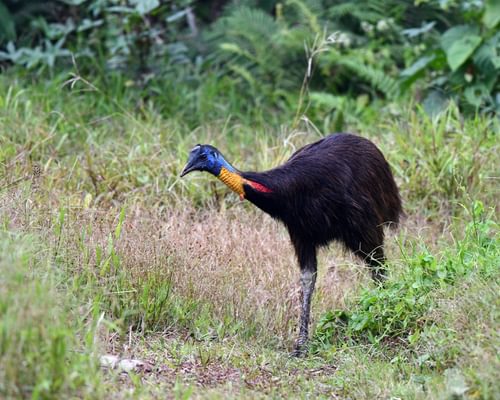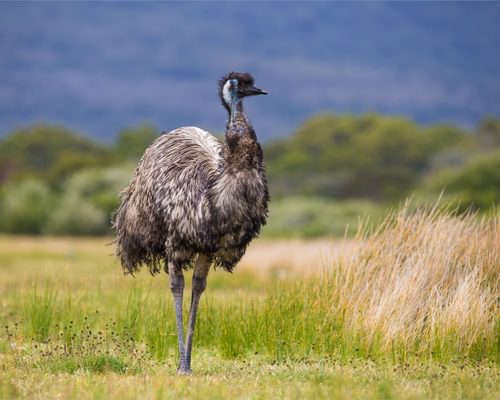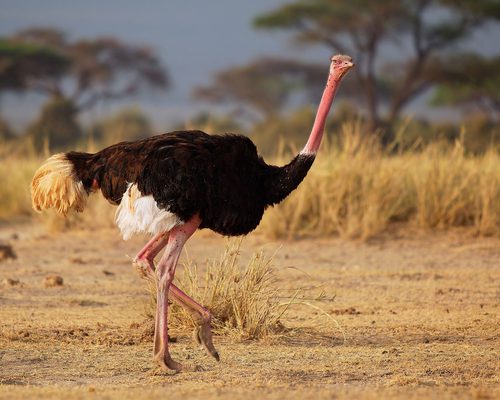Southern Cassowary
Least ConcernCasuarius casuarius
Visual Identification
Appearance
The Southern Cassowary is a striking, flightless bird with a tall, helmet-like casque atop its head. Its body is covered in glossy black feathers, with a vibrant blue neck, face, and two red wattles hanging from its throat. The bird stands up to 2 meters tall.
Females are typically larger than males, with a taller casque. Both sexes have powerful legs with dagger-like claws and small vestigial wings. Juveniles have brown plumage, gradually developing adult colouration as they mature.
Size
Length
127cm to 170cm
Wingspan
150cm to 200cm
Weight
29kg to 58.5kg
Colours
Males and females have similar plumage
Primary Colour
Black Blue
Secondary Colour
Red
Beak Colour
Grey
Leg Colour
Grey
Habitat and Distribution
Habitats
Woodland
Garden
Wetland
Coastal
Urban
Farmland
Grassland
Desert
Tundra
Rainforest
Mountain
Savanna
Distribution
Southern Cassowaries are found in the tropical rainforests of northeastern Australia, particularly in Queensland's Wet Tropics region. They also inhabit parts of New Guinea and nearby islands. These birds prefer dense, humid forests with a diverse array of fruit-bearing trees.
While their range has contracted due to deforestation, they can occasionally be spotted in more open woodlands or even beaches adjacent to their rainforest habitats, especially when searching for food.
Elevation Range
Sea level to 1,400 meters
Climate zones
Tropical
Distribution Map
This map gives you a rough idea of where you might spot a Southern Cassowary. The coloured areas show countries where these birds have been seen.
A few things to keep in mind:
- Birds might not be everywhere in the coloured areas, for example, they may be present around the coast of that country
- Where birds live can change with seasons and available food
- This map is quite simple - it doesn't show exact locations
We're working on making our maps even better! Soon, we hope to show you:
- More detailed maps for bigger countries, including state and region
- How birds move around during different seasons
Distribution by Region
Behaviour and Ecology
Bird Attributes
This feature is in beta. We'd love your feedback to improve it!
Share your thoughtsBird Attributes Explained
Our bird attributes system rates various aspects of a bird's capabilities on a scale of 0-100, based on data from field observations, scientific studies, and expert knowledge.
Attribute Categories:
- Agility: Manoeuvrability, speed, and grace in flight or movement.
- Strength: Physical power, often correlating with size and hunting abilities.
- Adaptability: Ability to thrive in various environments or changing conditions.
- Aggressiveness: Territorial behaviour and assertiveness, particularly during breeding seasons.
- Endurance: Stamina, often seen in migration patterns or foraging behaviours.
Understanding the Ratings:
- 0-20: Very Low
- 21-40: Low
- 41-60: Average
- 61-80: High
- 81-100: Very High
Remember, these attributes are relative to other bird species and don't necessarily indicate superiority.
Hover over the icon next to each attribute for more information.
Tap the icon next to each attribute for more information.
Agility
Reflects the bird's manoeuvrability, speed, and grace in flight or movement.
The Southern Cassowary displays remarkable agility for its size. It can run up to 50 km/h (31 mph) through dense forest and jump 1.5 metres high, showcasing impressive manoeuvrability in challenging terrain.
Strength
Indicates the bird's physical power, often correlating with size and hunting abilities.
With powerful legs and dagger-like claws, the Southern Cassowary is renowned for its strength. It's considered the most dangerous bird globally, capable of delivering potentially lethal kicks.
Adaptability
Represents the bird's ability to thrive in various environments or changing conditions.
While specialised for rainforest life, Southern Cassowaries show adaptability by occasionally venturing into open woodlands and beaches. They can also swim across rivers and even enter the sea for short distances.
Aggressiveness
Measures the bird's territorial behaviour and assertiveness, particularly during breeding seasons.
Southern Cassowaries are known for their aggressive defensive behaviour, particularly when protecting territory or offspring. Their reputation as dangerous birds stems from their willingness to confront perceived threats.
Endurance
Reflects the bird's stamina, often seen in migration patterns or foraging behaviours.
As large, flightless birds adapted to patrolling forest territories, Southern Cassowaries possess good endurance for sustained walking and foraging. However, their sprinting ability is likely limited to short bursts due to their size.
Diet
Southern Cassowaries are primarily frugivorous, consuming a wide variety of rainforest fruits. They play a crucial role in seed dispersal, swallowing fruits whole and passing the seeds intact.
Their diet is supplemented with small vertebrates, invertebrates, and fungi when fruit is scarce.
Behaviour
Southern Cassowaries are solitary and territorial, patrolling their rainforest domains with a purposeful stride. They're known for their powerful kicks, used for defense against predators or rivals.
These birds are excellent swimmers, capable of crossing rivers and even venturing into the sea for short distances.
Vocalisation
Southern Cassowaries are known for their deep, booming vocalisations that can be felt as much as heard. Their calls include low-frequency rumbles, grunts, and hisses.
During threat displays, they produce a series of thunderous booms that resonate through the rainforest, sounding almost prehistoric.
Nesting & Breeding
Breeding occurs during the Australian winter, typically from June to October. Males attract females with elaborate displays, including puffing up their feathers and producing low-frequency booming calls.
Females lay 3-5 large, pale green eggs in a simple nest on the forest floor, usually concealed by vegetation. The nest is a shallow depression lined with leaves and plant material.
Uniquely among large birds, male cassowaries perform all incubation and chick-rearing duties. They incubate the eggs for about 50 days and care for the chicks for up to 9 months, fiercely protecting them from predators.
Lifespan
The Southern Cassowary typically lives for 18 to 20 years, with a maximum recorded lifespan of 30 years.
Like all birds, lifespan can be affected by factors including predation, habitat quality, disease, and access to food sources.
Conservation and Status
Global Conservation Status
Although the Southern Cassowary is listed as Least Concern, it faces threats due to habitat loss and fragmentation. Road accidents and attacks by domestic dogs also pose significant threats.
Conservation efforts focus on protecting and connecting rainforest habitats, as well as educating local communities about coexistence with these important seed dispersers.
Birdwatching Tips
- Look for cassowaries in dense rainforest undergrowth, especially near fruit-bearing trees
- Listen for their low-frequency booming calls, which can travel long distances
- Be cautious and maintain a safe distance, as cassowaries can be aggressive if threatened
- In Australia, visit the Daintree Rainforest or Mission Beach area for the best chances of spotting one
Additional Information
Quick Facts
Other names:
Double-wattled Cassowary, Australian Cassowary
Family:
CasuariidaePredators
Adult cassowaries have few natural predators due to their size and defensive capabilities. However, eggs and chicks may fall prey to large pythons, dingoes, and feral pigs.
Did You Know?
- The Southern Cassowary is considered the most dangerous bird in the world due to its powerful legs and sharp claws.
- Their casque is made of keratin and may help amplify their low-frequency calls.
- Cassowaries can run up to 50 km/h (31 mph) through dense forest and jump up to 1.5 meters high.
- There are reports of Southern Cassowaries living for over 50 years in captivity.
Was this bird profile helpful?
Your feedback helps us improve our content
Thanks for your feedback!
Your input helps us improve our content.
Community Experience
Community Ratings
No ratings yet - be the first to rate this bird!
Latest Community Reviews
No reviews yet
Sign in to be the first to review
Community Reviews
Create Your Free Account Welcome Back!
Join our community to rate birds and share your experiences. Creating an account is completely free and only takes a minute. Sign in to your account to rate birds and share your experiences with our community.
Your information is secure and will never be shared.
By creating an account, you agree to our Privacy Policy.
Similar Birds
References
- 2
website: BirdLife International. 2018. Casuarius casuarius. The IUCN Red List of Threatened Species 2018: e.T22678108A131902050.
View source - 1 3 4
report, 2016: Dwyer et al.


